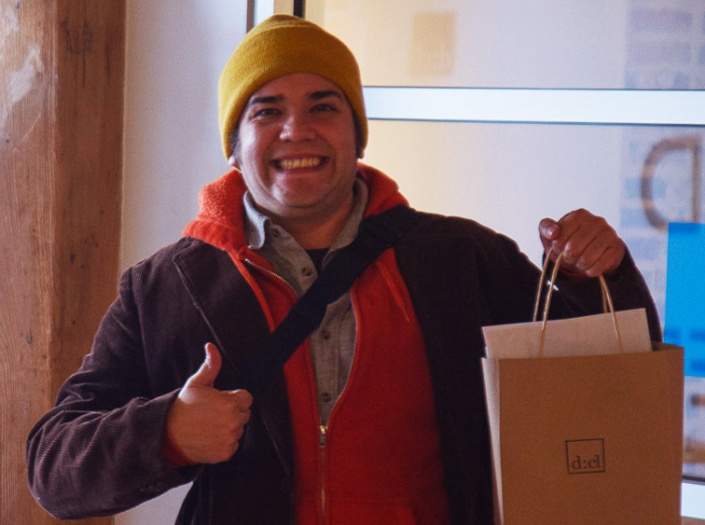aquaponics
Root Therapy at Design Cloud
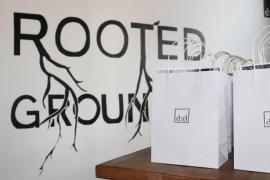 d;cl is an innovative space that acts as a design studio during the day and art gallery at night. Angela Bryant is their new Creative Director and she curated a show called Rooted; Grounded with Diana Gabriel and Benjamin Gardener. Intent on expanding the gallery experience, Angela hosted Root Therapy, a gardening workshop that calls attention to growing your own food, something that’s important to the lives of both the exhibiting artists, by bringing them together with leaders of the Good Food Movement in Chicago.
d;cl is an innovative space that acts as a design studio during the day and art gallery at night. Angela Bryant is their new Creative Director and she curated a show called Rooted; Grounded with Diana Gabriel and Benjamin Gardener. Intent on expanding the gallery experience, Angela hosted Root Therapy, a gardening workshop that calls attention to growing your own food, something that’s important to the lives of both the exhibiting artists, by bringing them together with leaders of the Good Food Movement in Chicago.
Fluency between disciplines of art and design strengthen our passions and inspire us. – Design Cloud
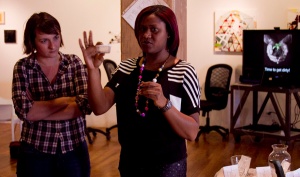
Benjamin couldn’t make it to the panel because he lives in Iowa but he sent some words of wisdom that attendees could take with them. From plants to sprouts to chickens, he shared research and first hand accounts of how to raise or forage for your own food. He even gives tips on finding out when to shop for certain veggies and ways to preserve veggies for when they aren’t in season. What I like about his approach is that he stresses making changes you can live with.
Small steps are the most productive form of rethinking and reevaluating your eating, purchasing and growing habits. – B. Gardener
Team CG’s contribution to Root Therapy was to speak on a panel with fellow food revolutionaries; Seneca Kern of WeFarm America, Breanne Heath of Growing Home and Keith Weber of Dragon R&D. We each had unique approaches to our gardening practices so audience members heard a diverse range of experiences from the experiential and artistic to the methodical and scientific. Our passions are each testaments to food’s potential to inspire individuals to do incredible things.
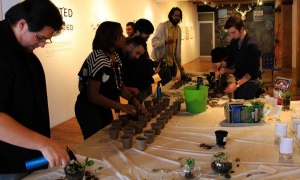
We spoke briefly about our development as gardeners and how we challenge ourselves by learning new things each year. We talked about our different successes and failures and how each year ends with a new problem to be solved. We also plugged the Cinematic Garden which will start again soon.
The second panelist was Seneca Kern, whom we heard at the Good Food Conference last year, his goal is to get more people interesting in gardening by sharing knowledge and fostering community. He tributes his grandmother, who was a sharecropper, for passing down the family tradition that lead him to gardening. He’s interested in the social consciousness that grows from sharing a gardening experience. WeFarm America even has a bicycle garden that they ride around and let people eat off of during public events. Seneca is a wizard at growing in small, unconventional spaces and he uses this magic to demystify the act of growing. Besides, if he can grow a full garden in a small wagon, you can surely grow on your patio or in your backyard.
 Seneca was followed by Breanne Heath from Growing Home, which focuses on teaching farming techniques to in Back-of-the-Yards through an agriculture and horticulture curriculum that Breanne developed for families to gain job training and access to good food. Her approach is very calculated because of her background in science. Some of her current ventures are “concocting the perfect compost tea recipe” and developing a seed library. She’s also gave us some insight into the planning that goes into growing a rooftop garden, where weight distribution becomes a factor.
Seneca was followed by Breanne Heath from Growing Home, which focuses on teaching farming techniques to in Back-of-the-Yards through an agriculture and horticulture curriculum that Breanne developed for families to gain job training and access to good food. Her approach is very calculated because of her background in science. Some of her current ventures are “concocting the perfect compost tea recipe” and developing a seed library. She’s also gave us some insight into the planning that goes into growing a rooftop garden, where weight distribution becomes a factor.
Keith Weber, of Dragon R&D, brought a different vibe than the rest of us. He’s a DePaul student and an aquaponics enthusiast… Hope I got that right. One of his pet peeves is that the terminology used in hydro/aqua/aeroponics is redundant, confusing and ultimately off-putting. His breakdown of the words and proposal on how to simplify them remind me of something I’ve heard a lot about on NPR, Code Switching. As our world grows smaller, cultures and languages converge. Ways of communicating expand as part of the process. What Keith found is that having too many terms for similar growing techniques leads to confusion, bad yields and wasted money so he wants to simplify the terms so that everyone knows what they’re talking about.
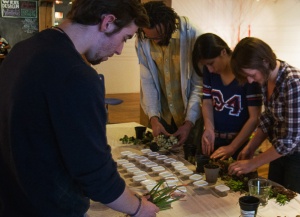
Keith’s crusade touched on an idea that all the panelists connected with. The language of hydro/aqua/aeroponics can be daunting and it gets in the way of us learning anything about the subject. The same thing happens in art. There’s always an overpriced art kit for the new medium you want to try, so you shop around and find that each store has their own kit with slightly different ways of describing the ingredients. Not wanting to commit $100+ to an experiment, you struggle to put together a kit with loose items and refills. You think you saved a bunch of money but it turns out that the ingredients don’t match. Maybe one is water based and the other is oil, maybe the sizes don’t match up. Whatever it is, it sours the experience and you never try it again. Your money and time were wasted; you’ll always wonder, “What if I’d just bought the kit?”
 Let’s say you were curious enough and could afford to buy the kit. Not only do the ingredients and sizes of all the materials match but there are booklets or DVDs to guide you through the process for that specific kit. If it doesn’t go right, you shove it aside and never speak of it again. If it does go right, you’re fluent in that company’s language of that medium so any advice you give to friends will carry that brand’s lingo. Your friend then mixes advice from you and someone using another brand and gets all confused. In the world of hydro/aqua/aeroponics, where kits cost thousands of dollars, the sticker price keeps many of us from even considering this kind of experimentation. Keith wants to make the break down that barrier by uniting the dialects instead of further dividing them.
Let’s say you were curious enough and could afford to buy the kit. Not only do the ingredients and sizes of all the materials match but there are booklets or DVDs to guide you through the process for that specific kit. If it doesn’t go right, you shove it aside and never speak of it again. If it does go right, you’re fluent in that company’s language of that medium so any advice you give to friends will carry that brand’s lingo. Your friend then mixes advice from you and someone using another brand and gets all confused. In the world of hydro/aqua/aeroponics, where kits cost thousands of dollars, the sticker price keeps many of us from even considering this kind of experimentation. Keith wants to make the break down that barrier by uniting the dialects instead of further dividing them.
Everyone on the panel was working toward their own kind of open source collection of resources. Good Food and Art are both dependent on the free exchange of ideas and knowledge. At their best, both movements serve the common goal of liberating people from constructs that keep them disconnected from one another. Finding ways to monetize knowledge and experience while remaining inclusive is a huge challenge we both face and the answers to it are constantly evolving.
If there was one topic I’d liked to have heard more about on the panel, it would have been permaculture. Some of us spoke abstractly on the idea but it would have been nice to bring some facts about the practice and its benefits to the ecosystem. My limited understanding of the practice lead me to suggest that we’re experimenting in art permaculture now. Meaning that individual artists and collectives identify deficiencies in the current art scene the way farmers diagnose problems in a garden or farm. In this case, Angela Bryant had the idea an art gallery was a great place to get dirty and sow some seeds.
Design Cloud sent us home with a succulent terrarium and some lettuce seeds to grow at home. The beauty of succulents are that they are hard to kill. I was given an aloe vera plant by an old friend, which I kept alive for years before we ever started growing food. They’re a great intro to gardening.
